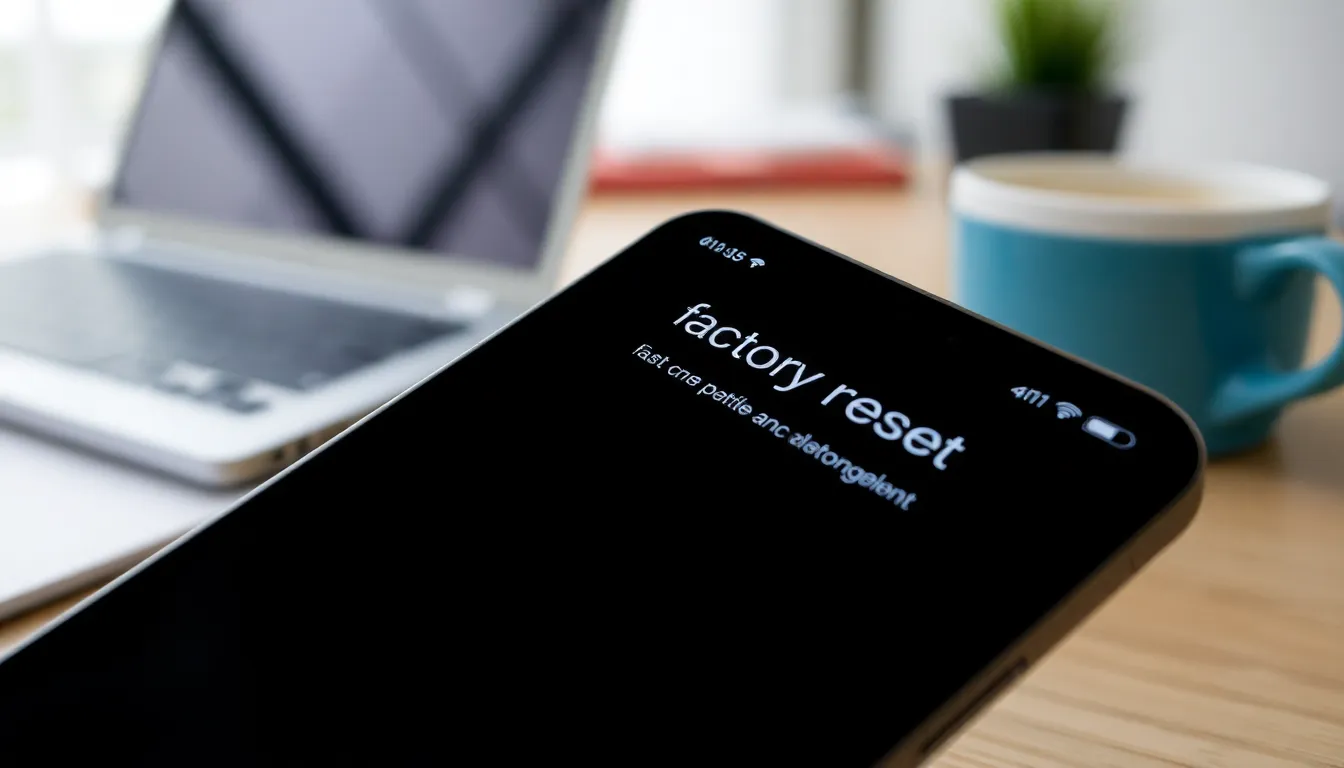Table of Contents
ToggleEver felt like your iPhone’s more temperamental than a cat on a hot tin roof? If so, a reset might just be the magic trick you need. But what really happens when you hit that reset button? Spoiler alert: it’s not like sending your phone to the spa for a relaxing day.
Understanding iPhone Resets
Resetting an iPhone can resolve various issues, restoring functionality. Users often seek clarity on what types of resets exist and their implications.
The Difference Between Soft Reset and Hard Reset
A soft reset, often referred to as a simple restart, refreshes the device without deleting content. This process closes apps and clears memory, addressing minor glitches. A hard reset, or force restart, interrupts normal operation when an app freezes or the phone becomes unresponsive. Engaging in a hard reset requires pressing specific button combinations, helping restore responsiveness without loss of data.
What Is a Factory Reset?
A factory reset erases all personal data and settings, returning the device to its original state. This process reinstalls iOS while removing apps, photos, and contacts. Users typically opt for this when selling their phones or troubleshooting persistent problems. Before initiating a factory reset, backing up important data is essential, as recovery post-reset is impossible.
Effects of Resetting Your iPhone

Resetting an iPhone significantly alters its functionality and data storage. Understanding the specific effects helps users make informed decisions.
Data Loss and Backup Considerations
Data loss occurs when a factory reset is performed. Personal information, photos, and app data disappear unless backups are created. iCloud and iTunes provide effective backup solutions. Users should regularly back up data to prevent permanent loss. Restoration of information from backups becomes crucial post-reset. Streamlined backup processes can ease this transition. Ensuring all important files are secured before resetting proves essential.
System Settings and Preferences
Resetting an iPhone restores system settings to default. Customizations, like Wi-Fi passwords and display preferences, revert to factory settings. Users often experience a fresh start, but they must reconfigure their personal settings. Accessibility settings also return to their original states, which may disrupt usage for some. Personal app arrangements and themes get erased as well. Rebuilding preferences becomes necessary after the reset. Some users find this process tedious but advantageous for device performance.
Steps to Reset Your iPhone
Resetting an iPhone requires careful preparation and execution to ensure data safety. Following specific steps can facilitate a smooth transition.
Preparing Your Device
Back up essential data before proceeding with any reset. iCloud provides a straightforward backup option, while iTunes offers a desktop alternative for those preferring local storage. Checking that the device’s battery is adequately charged prevents interruptions during the reset process. Users should also note any important settings they want to remember. Ensuring Wi-Fi passwords and display preferences are documented aids in reconfiguring the device post-reset. Confirming that all necessary information is saved reduces the risk of permanent data loss.
Performing the Reset
Accessing the reset options is simple. Navigate to Settings, then tap on General, followed by Transfer or Reset iPhone. Choose either Reset All Settings for a less intrusive option or Erase All Content and Settings for a full factory reset. Confirm the selection, and the device will begin the process. During a factory reset, the iPhone restores to its original settings, erasing all apps, files, and personal configurations. Completion may take several minutes, depending on the device’s storage. After the reset, the iPhone prompts for setup, allowing users to restore from backups.
Common Misconceptions About Resetting
Resetting an iPhone holds several misconceptions that users often believe. These misunderstandings can affect their approach to device management.
Will It Remove My Apple ID?
Resetting an iPhone does not automatically remove an Apple ID. The user retains access to their account, but a factory reset may prompt reauthentication. Users need to know that after a reset, they’ll still require their Apple ID and password to sign back in. This step helps protect personal information linked to the Apple ID. In some cases, users may encounter Activation Lock during setup, requiring the Apple ID for access. Helpful documentation from Apple outlines procedures for bypassing issues related to Apple ID access.
Can It Fix Performance Issues?
Certain performance issues can improve after an iPhone reset. Users observe quicker response times, smoother navigation, and enhanced overall functionality following a reset. Clearing cached data often leads to these improvements, eliminating lingering software bugs. It’s important to note that a simple soft reset may also resolve minor performance issues without data loss. Should significant problems persist, users might need to consider other solutions in combination with a reset, such as software updates or hardware checks. Users can find additional resources from Apple to gauge when a reset is needed for performance enhancement.
Resetting an iPhone can be a powerful tool for addressing performance issues and restoring functionality. Whether opting for a soft reset or a full factory reset users should approach the process with caution. The potential for data loss makes backing up essential before proceeding.
While the reset can lead to improved responsiveness and smoother operation it also requires users to reconfigure their settings and restore their data from backups. Understanding the implications of each type of reset empowers users to make informed decisions about their devices. Ultimately a well-executed reset can breathe new life into an iPhone and enhance the overall user experience.







